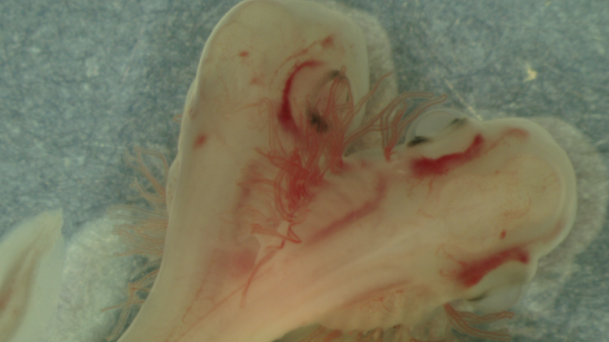

You’ve probably seen a weird image popping up around the internet lately: A very grumpy looking two-headed shark cupped in the palm of someone’s hand. But are scientists “BAFFLED” by the fact that these “MUTANT SHARKS!” are popping up everywhere? No, not really.
While the thought of bloodthirsty mutants – snarling with twice the bite – is enough to make 2016 sound (even more) like the end of the world, the real story is more grounded. This image, which is eight years old, is cropping up again because of a new, similar study published in October. Researchers in Spain were watching the development of nearly 800 Atlantic sawtail catshark embryos in a lab when one caught their eye.
“Of the 797 embryos examined, the anomalous specimen represents a defect incidence of 0·13%, which seems to be the first estimation of the frequency of dicephalia in sharks,” the researchers write in their study, published in the Journal of Fish Biology.
Dicephalia, as you’ve probably guessed, is the condition of having two heads. In this case, the study authors note, “each head had a mouth, two eyes, a brain, a notochord and five gill openings on each side. The two heads fused behind the gills. … There were two hearts, two oesophaguses, two stomachs, two livers, but a single intestine with a spiral valve.” It’s the first time anyone’s documented a two-headed shark embryo in an oviparous (egg-laying) shark species.
While it’s tempting to hit the panic button on the world’s oceans — surely toxic sludge being pumped into the water is creating these mutant shark monsters, right? — it’s difficult to pin the blame for these two-headed babies on human pollution. In fact, the study’s lead author Valentín Sans-Coma told National Geographic that a genetic disorder seems to be “the most plausible cause for the two-headed catshark,” since the embryos were grown in a lab among 800 brothers and sisters. So these freakish looking fish aren’t the result of radioactive Chemical X, but a fluke of nature. Like the two-headed bull shark found in the Gulf of Mexico in 2013, there’s not strong evidence that they’re born this way due to dirty waters.
For some shark species, it’s simply a matter of quantity: Blue sharks, for example, carry up to 50 embryos at a time, some of which are bound to be genetically abnormal — as was the case in a 2011 study.
The perceived uptick in two-headed sharks could also be a result of more researchers studying shark embryos. There are more eyes on these creatures than ever – which means more four-eyed sharks get spotted –and more journals for researchers to publish their findings in. Two-headed animals have been reported for decades, and in an 1800s form of science clickbait, they were known as “double monsters.” Nothing changes.
Because the embryo was killed for the October study, we’ll never know if it could have survived in the wild — but the odds for this double-wide swimmer would have been slim. “Survival after birth may occur, but would likely be very brief,” Michelle Heupel, a researcher at the Australian Institute of Marine Science told Hakai Magazine. “It is unclear whether the two heads will preclude swimming and prey capture, and whether joined internal organs will function adequately.” They’d never survive to swim on their own, let alone pull off a “2-Headed Shark Attack.” Whether that’s a relief or a bummer is totally up to you.
